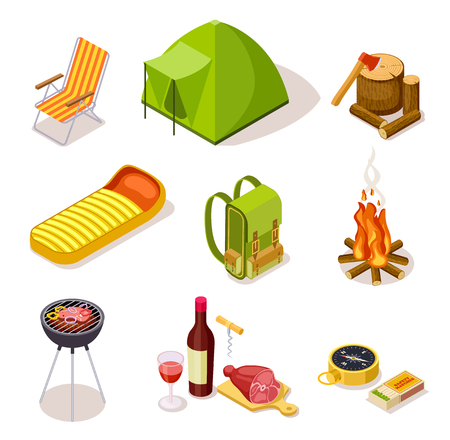1. Understanding Different Types of Camp Grills
When it comes to picking the perfect camp grill, knowing the different types available is key. Each type has its own pros and cons depending on your camping style—whether youre car camping for the weekend or backpacking deep into the woods. Lets break down the three most common types of camp grills: propane, charcoal, and wood-burning.
Propane Grills
Propane grills are a favorite among campers who want convenience and quick cooking times. These grills run on small propane canisters that are easy to attach and replace. Theyre great for RV camping, tailgating, or any situation where you have space to carry extra gear.
Pros:
- Quick and easy setup
- Temperature control with adjustable knobs
- No need to deal with ash or coal cleanup
Cons:
- Heavier and bulkier than other types
- Requires carrying fuel canisters
- Less “authentic” campfire flavor
Charcoal Grills
Charcoal grills give you that smoky flavor many campers love. Theyre a solid choice if youre looking for that classic BBQ taste and dont mind spending a little more time on prep and cleanup.
Pros:
- Delivers rich, smoky flavor
- Usually more compact than propane grills
- No need for pressurized gas tanks
Cons:
- Takes longer to heat up
- Difficult to control temperature precisely
- Ash cleanup required after use
Wood-Burning Grills
If youre going off-grid or want to keep it as rustic as possible, wood-burning grills are a great option. These use sticks, logs, or wood pellets you find at your campsite (or bring with you) as fuel.
Pros:
- No need to carry fuel—use whats around you
- Adds authentic campfire flavor to food
- Lighter options available for backpackers
Cons:
- Can be restricted in areas with fire bans
- Longer cook times and more effort needed for setup
- Difficult to maintain consistent heat levels
Camp Grill Comparison Table
| Type of Grill | Portability | Setup Time | Cooking Control | Flavor Profile |
|---|---|---|---|---|
| Propane Grill | Medium to Low (heavier) | Fast (plug and play) | Excellent (adjustable knobs) | Mild, clean taste |
| Charcoal Grill | Medium (compact models available) | Moderate (15–30 mins) | Moderate (manual heat control) | Smoky BBQ flavor |
| Wood-Burning Grill | High (lightweight options exist) | Slow (collect wood & start fire) | Difficult (requires practice) | Rich, natural wood-smoked flavor |
The right camp grill depends on how you like to camp. If you’re all about ease and speed, propane is probably your best bet. Love that BBQ flavor? Go charcoal. Want the full rustic experience? A wood-burning grill might be the one for you.
2. Matching Your Grill to Your Camping Style
When it comes to choosing the right camp grill, your camping style plays a huge role in determining what kind of grill will work best for you. Whether youre car camping with the family, backpacking solo through the wilderness, or living the RV life on the road, different grills offer different benefits. Let’s break it down so you can find the perfect match.
Car Camping
If youre driving to your campsite and have room in your trunk, weight and size aren’t major concerns. You’ll want a grill that’s easy to use, offers enough cooking space for your group, and is durable enough for frequent weekend getaways.
Top Features to Look For:
- Fuel Type: Propane for easy ignition and heat control
- Cooking Space: Medium to large grilling area (200–400 sq. in.)
- Portability: Foldable legs or tabletop design
- Bonus Features: Side tables, built-in thermometer, push-button ignition
Backpacking
If you’re carrying everything on your back, your grill needs to be lightweight and compact. In this case, simplicity is key—you’ll want something thats easy to pack, set up, and clean.
Top Features to Look For:
- Fuel Type: Solid fuel tablets or small butane canisters
- Cooking Space: Just enough for one or two meals (under 100 sq. in.)
- Portability: Ultra-lightweight and foldable or collapsible design
- Bonus Features: Multi-use design (grill + stove combo), quick-cooling materials
RV Camping
If youre traveling in an RV, you likely have access to more storage space and possibly even built-in power sources. A larger grill with advanced features can make outdoor cooking a breeze while still being portable enough to store after meals.
Top Features to Look For:
- Fuel Type: Propane or electric (if hookups are available)
- Cooking Space: Large grilling surface (300+ sq. in.)
- Portability: Wheeled stand or detachable tabletop model
- Bonus Features: Multiple burners, griddle attachments, easy-clean drip trays
Camping Style Comparison Table
| Camping Style | Recommended Fuel Type | Grill Size | Main Priorities |
|---|---|---|---|
| Car Camping | Propane | 200–400 sq. in. | User-friendly, medium-sized, durable features |
| Backpacking | SOLID FUEL / Butane | <100 sq. in. | Ultra-lightweight, compact, easy setup/cleanup |
| RV Camping | Propane / Electric | >300 sq. in. | Larger capacity, convenience features, storage friendly |
No matter how you like to camp, there’s a grill out there that fits your lifestyle perfectly. Knowing what matters most for your specific camping setup helps narrow down your options and ensures every meal outdoors is a success.

3. Key Features to Look For
Choosing the right camp grill isn’t just about picking the biggest or most expensive one. It’s about finding a grill that fits your camping style and makes outdoor cooking easy and enjoyable. Here are some essential features you should consider when shopping for a camp grill:
Adjustable Heat Levels
Different foods require different cooking temperatures. A grill with adjustable heat settings gives you better control whether youre searing steaks or gently heating up veggies. Look for grills with multiple burners or adjustable knobs to fine-tune your flame.
Easy Cleanup
After a long day of hiking and eating, the last thing you want is a messy cleanup job. Removable grease trays, non-stick grates, and dishwasher-safe parts can make cleaning up way less of a hassle.
Cooking Surface Size
The size of the cooking surface matters depending on how many people youre feeding. Heres a quick guide to help you choose:
| Group Size | Recommended Cooking Surface |
|---|---|
| 1-2 People | 100-200 sq in |
| 3-5 People | 200-400 sq in |
| 6+ People | 400+ sq in |
Fuel Efficiency
If youre car camping, you might not worry too much about fuel use. But if youre backpacking or going off-grid, a fuel-efficient grill can save space and weight in your pack. Look for models that offer good burn time per fuel unit and even heating without wasting gas or charcoal.
Other Handy Features
- Portability: Foldable legs, carrying handles, or compact design for easy transport.
- Durability: Stainless steel or cast iron materials hold up better over time.
- Ignition System: Push-button or electric ignition saves you from fumbling with matches.
- Lid and Wind Protection: Helps maintain heat and keep flames steady in breezy conditions.
These key features can make all the difference when choosing the perfect camp grill. Think about what matters most to your camping experience—whether it’s grilling burgers at a tailgate party or making coffee at sunrise deep in the backcountry—and let those priorities guide your decision.
4. Top Picks for Camp Grills Available in the U.S.
Choosing the right camp grill can make all the difference in your outdoor cooking experience. Whether youre a weekend camper, a backpacker, or an RV traveler, theres a grill out there that fits your needs. Heres a curated list of popular and reliable camp grills available from major U.S. retailers like REI, Amazon, and Walmart. Each option comes with a quick look at its pros and cons to help you decide which one works best for your camping style.
Top Camp Grill Picks
| Model | Type | Pros | Cons |
|---|---|---|---|
| Weber Q1200 Portable Gas Grill | Propane | – Easy to use – Great heat distribution – Built-in thermometer |
– Heavier than other portable options – A bit pricey for casual campers |
| Coleman RoadTrip 285 Stand-Up Grill | Propane | – Large cooking surface – Adjustable burners – Collapsible stand for easy transport |
– Bulky for backpacking – Takes up more trunk space |
| Lodge Cast Iron Sportsmans Grill | Charcoal | – Durable cast iron build – Excellent heat retention – Traditional charcoal flavor |
– Heavy – Requires more cleanup and setup time |
| BIO LITE FirePit+ Grill Combo | Wood/Charcoal (Battery-powered fan) | – Smokeless fire feature – Can be used as both fire pit and grill – Rechargeable battery pack with USB charging |
– Limited cooking surface – Needs power to operate the fan efficiently |
| Eureka! SPRK+ Butane Camp Grill | Butane | – Lightweight and compact – Easy ignition system – Ideal for car campers and small groups |
– Not ideal for high altitudes – Butane canisters may be less available than propane in some areas |
| Cuisinart CGG-180T Petit Gourmet Portable Tabletop Gas Grill | Propane | – Compact size with foldable legs – Good value for the price – Quick setup and cleanup |
– Smaller cooking area – Not ideal for large families or groups |
| Solo Stove Ranger + Grill Top Bundle | Wood/Biomass | – Dual-purpose as stove and grill – Super efficient burn with minimal smoke – High-quality stainless steel construction |
– Premium price tag – Learning curve for new users unfamiliar with wood-burning stoves |
Tips When Choosing Your Camp Grill:
- Your Camping Style Matters: Backpackers should aim for lightweight grills, while car campers can opt for sturdier models with more features.
- Simplicity vs. Features: Some grills offer extra features like thermometers or collapsible stands—great if you need them, but they add weight and cost.
- Your Fuel Preference: Propane is widely available and easy to use, while charcoal offers better flavor but requires more effort.
- Packing Space: Make sure your grill fits comfortably into your vehicle or backpack without taking up too much room.
- Campsite Rules: Check if your destination allows open flame or has restrictions on certain fuel types.
Selecting the right camp grill isnt just about price—its about finding what fits your outdoor lifestyle best. The models above are trusted by American campers and offer solid performance no matter where your adventure takes you.
5. Safety Tips and Maintenance Essentials
When youre out in the wild, cooking over a camp grill can be one of the highlights of your trip—but it also comes with some risks. Whether youre using a gas grill, charcoal setup, or a compact backpacking stove, knowing how to use and maintain your gear safely is crucial. Here’s how you can stay safe and keep your grill in top shape for many camping trips to come.
Grill Safety: Preventing Fires and Accidents
Outdoor cooking always requires attention to safety. A simple mistake can quickly turn into a dangerous situation. Follow these tips to reduce risks:
- Choose a Safe Location: Always set up your grill on flat, non-flammable surfaces like gravel or dirt, away from dry grass, tents, and trees.
- Never Leave It Unattended: Keep an eye on your grill while its hot or in use. Fires can spread quickly if left unattended.
- Keep Water or a Fire Extinguisher Nearby: Be prepared for flare-ups or accidents by having water, sand, or a fire extinguisher ready.
- Avoid Overloading with Grease: Excess grease can cause flare-ups. Use drip trays or manage fat drippings carefully.
- Check for Gas Leaks: For propane grills, check hoses and connections before each use by applying soapy water to joints—bubbles mean there’s a leak.
Maintenance Must-Dos: Extend Your Grill’s Life
A well-maintained grill not only lasts longer but also performs better. Heres what you need to do after every trip and during off-season storage:
| Maintenance Task | When to Do It | Why It Matters |
|---|---|---|
| Clean Grates & Surfaces | After Every Use | Prevents buildup of grease and food that can cause flare-ups and bad flavors |
| Empty Ashes (Charcoal Grills) | After Every Use | Ash absorbs moisture and can lead to rust if left inside the grill |
| Inspect Gas Lines & Connections | Before Each Use (Gas Grills) | Keeps you safe by avoiding potential leaks or explosions |
| Store Properly | After Each Trip | A dry, covered spot helps prevent rust and weather damage |
A Few Extra Tips:
- If youre storing your grill for the winter, give it a deep clean and cover it with a weatherproof tarp.
- Use only approved cleaning tools—wire brushes can leave bristles behind that might end up in your food!
Taking time to follow these safety tips and maintenance routines will make sure your camp grilling experience stays fun—and safe—for seasons to come.


